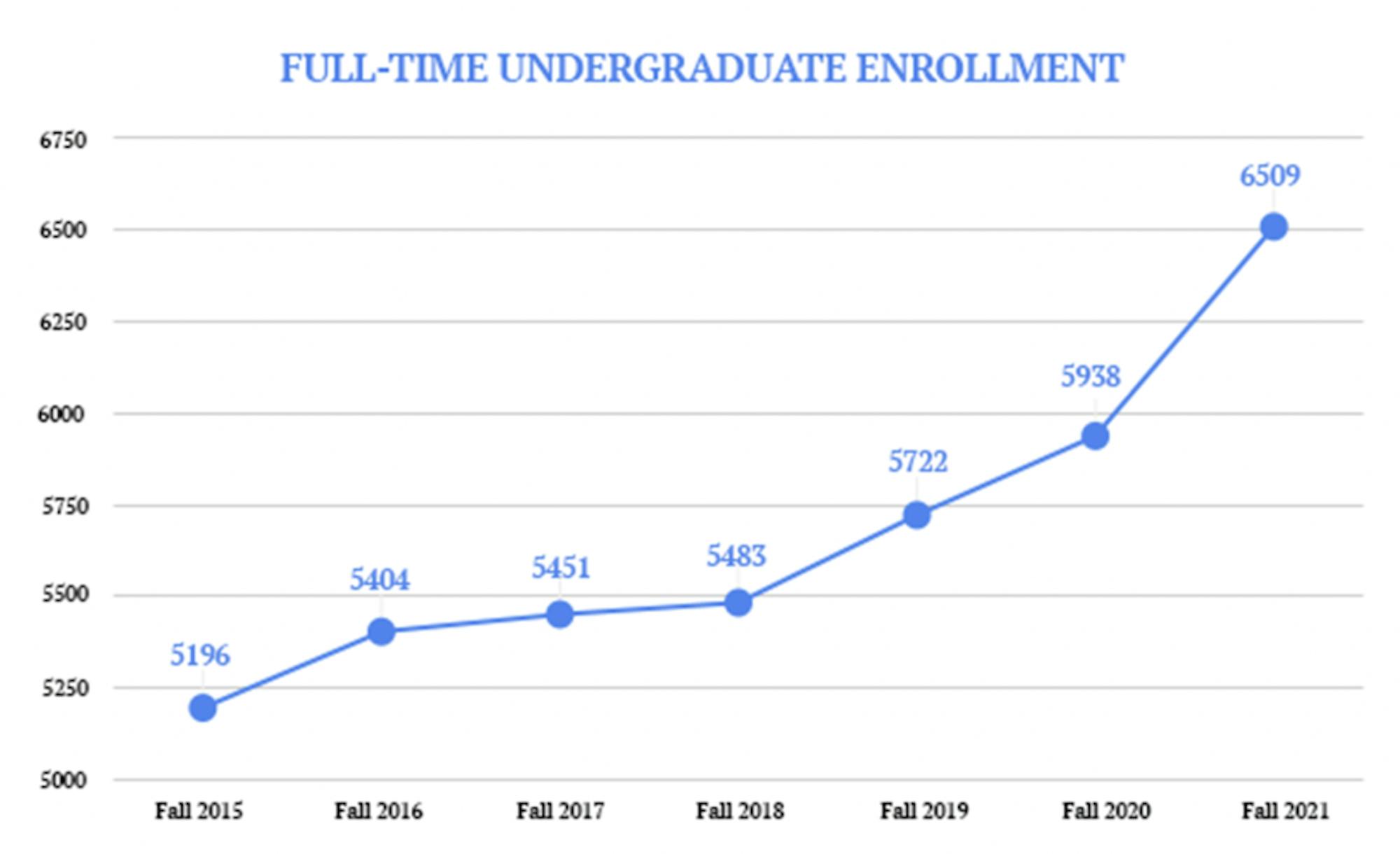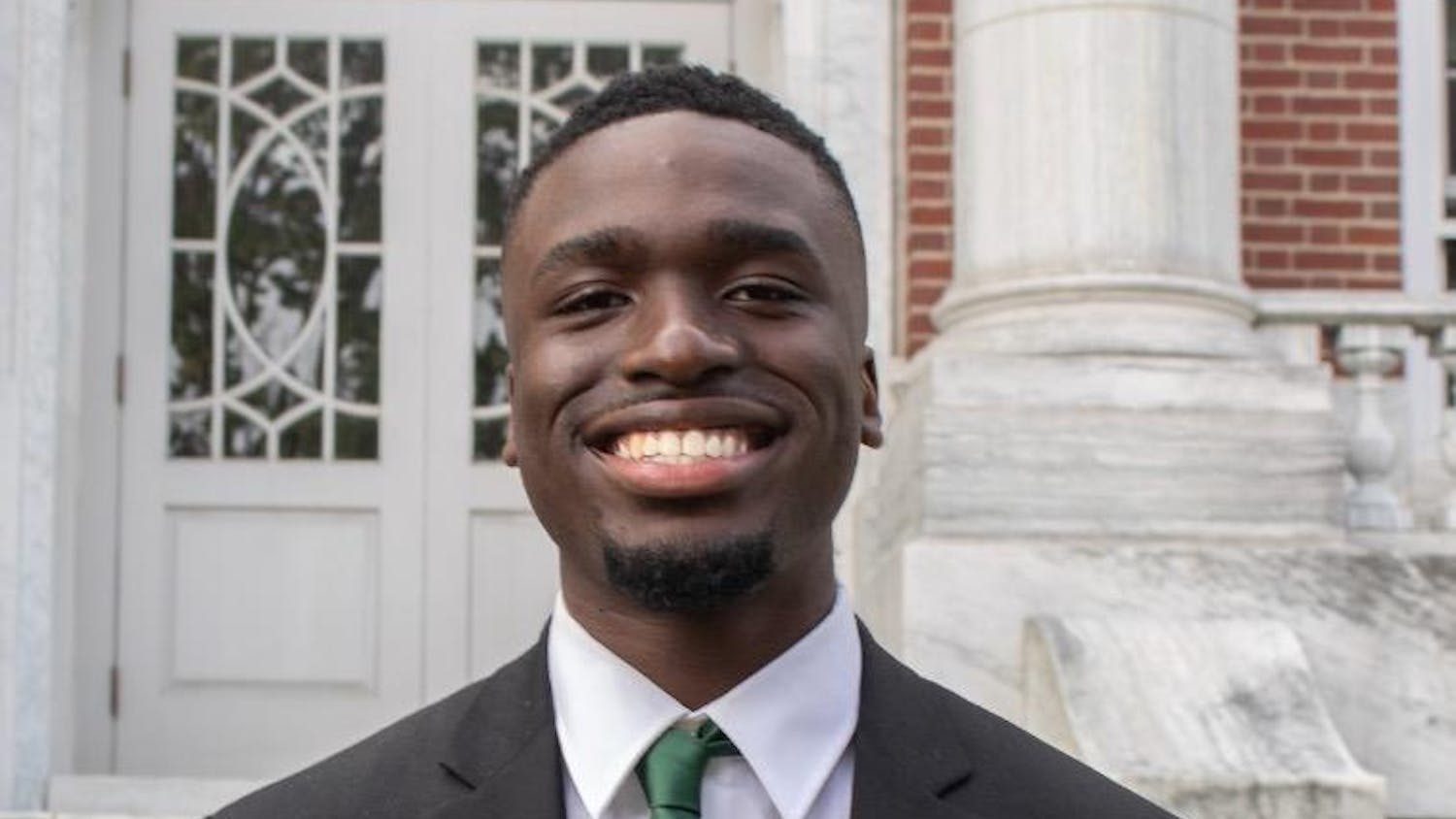Editor's note: This is the first of a two-part series on the expansion of Tufts' undergraduate enrollment. Read the second part here.
While Tufts University has been a member of the New England Small College Athletic Conference since 1971, it may now be a misnomer to call Tufts a “small college.” With over6,500 undergraduates at the beginning of the 2021–22 school year, including part-time and full-time students, Tufts’ undergraduate enrollment is by far the largest in the NESCAC and is currently larger than that of Johns Hopkins, Princeton and Yale, some of the nation’s best-known research universities.
Most notably, the fall 2021 undergraduate enrollment for full-time students represents a 25.3% increase from the fall 2015 term, as the university has undergone a net increase of more than 1,300 students in the past six years. With a size of 1,807 students, the Class of 2025 was also the largest incoming class in the university’s history, leading many to question how many more students Tufts can realistically accommodate in the future.
Many students, in fact, have expressed how the university’s ever-increasing enrollment has negatively impacted their undergraduate experience, fromlonger lines in the dining halls to crowded libraries and difficult course registrations. Some first-years even had difficulties registering for Expository Writing, one of the university’s graduation requirements that students typically complete during their first year.
Class of 2025 TCU Senator Natalie Rossinow shared some of the challenges that her class has had to navigate, many of which are traceable to this year’s overenrollment.
“In the beginning of last semester … I remember waiting in line for Dewick outside and [the line] was wrapped around [the building] and then we're like ... maybe we go to Carm for dinner and we waited in line at Carm for an hour,” Rossinow said. “Sometimes we would get there to get our food and the food would run out, and then they would have to make more food.”
Rossinow also noted that it was challenging for some of her friends who could not register for the courses that they are required to take.
“Especially for the classes that they're requiring us to take, like English [1 or 2] ... There's not enough English 1 classes — that doesn't really make sense,” Rossinow said. “Or with English 2, same thing, [Tufts requires] us to take it and there's not enough classes … What do you want us to do about that?”
Rabiya Ismail, a senior, added that the Medford/Somerville campus has felt more crowded lately than in previous years.
“I work at the Campus Center, and I have definitely noticed an influx in people asking for rooms, just ... how many people are in the Campus Center daily … It's way busier than it has been, especially [since] last year,” Ismail said. “Oftentimes, there’s not a place for students to study, so if they come in [to the Campus Center] and ask for a room, I have to say that 'Oh, all the rooms are full' ... and then they might say, ‘Well I can't find a room elsewhere, Tisch has all been booked.’”
Overall, Ismail expressed her concern that increasing the size of the student body would dilute the university’s resources, such as the student body’s access to Counseling and Mental Health Services. According to university administration, however, Tufts plans on maintaining the current number of students and even adding more full-time undergraduates in the foreseeable future.
Patrick Collins, Tufts' executive director of media relations, explained in an email to the Daily that the university is “halfway through a multi-year enrollment growth management plan” that will “level off with an undergraduate student body of approximately 6,600 full-time students” by 2026. For context, in fall 2021, there were 6,509 full-time undergraduate students.
Collins explained how the undergraduate expansion is in line with the university’s long-term interest and strategic plans.
“Growth in enrollment is a sign of the university’s status and strength and is the result of a long-term strategy that will put a Tufts education within reach of more students, solidify the financial footing of our undergraduate schools and programs and provide for the kinds of facilities needed to support world-class teaching and research,” Collins wrote.
Echoing Collins’ sentiments, Dean of the School of Arts and Sciences James Glaser elaborated on the salience of increasing undergraduate enrollment.
“The larger base of students gives us the ability to do bigger and better things and to have better facilities, to have a larger faculty,” Glaser said. “And, you know, we're an ambitious place. We are not just standing still.”
While highlighting the potential benefits of increasing undergraduate enrollment, Collins also acknowledged that this year’s overenrollment has brought about many unforeseen logistical challenges to the university administration's strategic plans.
“Due to faster than anticipated enrollment this year that was largely the result of extraordinary forces related to the pandemic, we have reached some of our targets ahead of schedule,” Collins wrote. “We anticipate that enrollment growth will slow during the remaining years of the plan, enabling related priorities to catch up over the next couple of years.”
Collins attributed this year’s spike in undergraduate enrollment to a host of complicating factors.
“The university adopted a test-optional admissions process in response to pandemic restrictions, which increased applications and made our yield models less predictable,” Collins wrote. “At the same time, far fewer students than typical opted to study abroad and to take leaves this year, further driving up enrollment. This year, leaves are at their lowest level in at least the last 8 years.”
On top of that, Glaser discussed some of the university’s institutional efforts to meet the new demands from overenrollment, which have been compounded by the ongoing COVID-19 pandemic.
“As a full-need institution, we’re ... committed to changing aid packages if there’s a change in a student’s demonstrated need,” Glaser said. “We had to prepare for that, and that required going out and talking to our benefactors and people who care about the school and our students ... [They certainly] came through for us.”
Even as the university continues to address this year’s over-enrollment, Max Miller, a senior and trustee representative for the TCU Senate, questioned whether the university’s overarching plan to increase its undergraduate enrollment to 6,600 full-time students by 2026 would impact campus culture. He explained that it was the university's size that initially drew him to Tufts.
“A major consideration of mine coming to Tufts was the size. As far as I can remember, there are not that many schools that are 5,000 people,” Miller said. “It is either the NESCAC [schools] that are tiny and in the middle of nowhere … or it’s [a] big city school or [a] big state school. One of the things that made me want to come to Tufts was that Tufts seemed to ride that line.”
While Rossinow ultimately found the size of Tufts ideal and applied Early Decision I, she can also see how some might prefer a smaller college environment.
"I think we are ... not shifting away from the liberal arts vibe because we still have that, but we are evolving," Rossinow said. "And I think that that will attract some people, and it'll also turn some people away.”
Moving forward, Glaser said that the challenge is to find the "right equilibrium" that will help Tufts solidify its position as a major research university while preserving the best aspects of the Tufts experience for its undergraduates.
“Our size does matter: we are the smallest big university or the biggest small university in the country. And that means that it's a place where I think that students can expect that there will be personal attention, that they’ll know their faculty ... but that there's a cornucopia of opportunities that you get in a large place," Glaser said. “Our job [is] to find the right equilibrium between the number of students and the resources that are available. And ... we are in the process of establishing that new equilibrium.”






